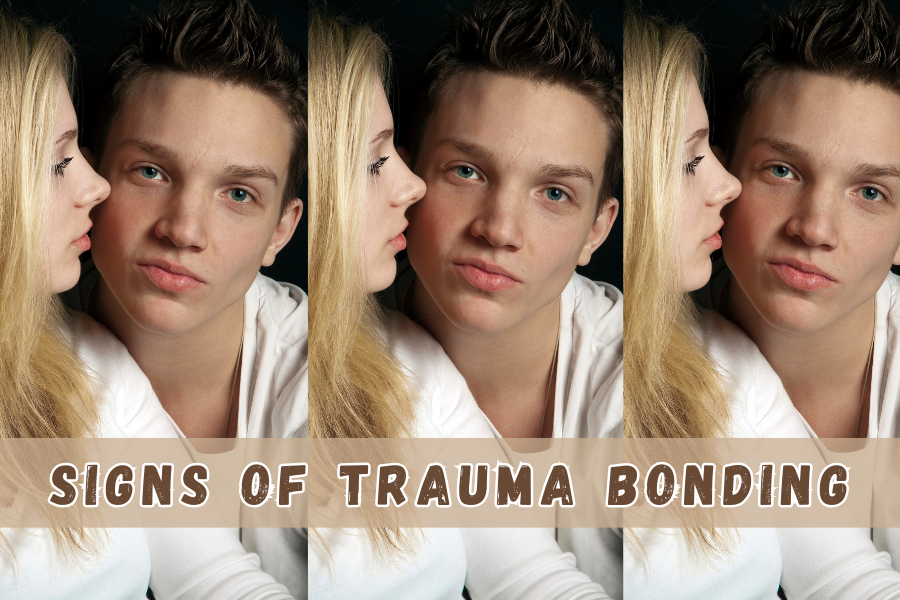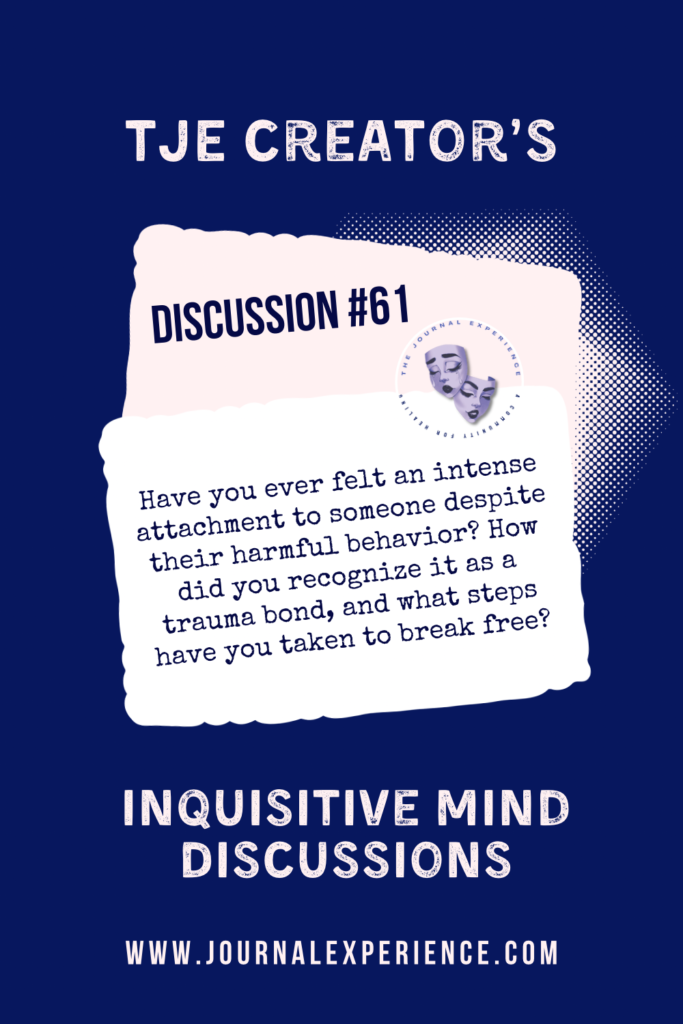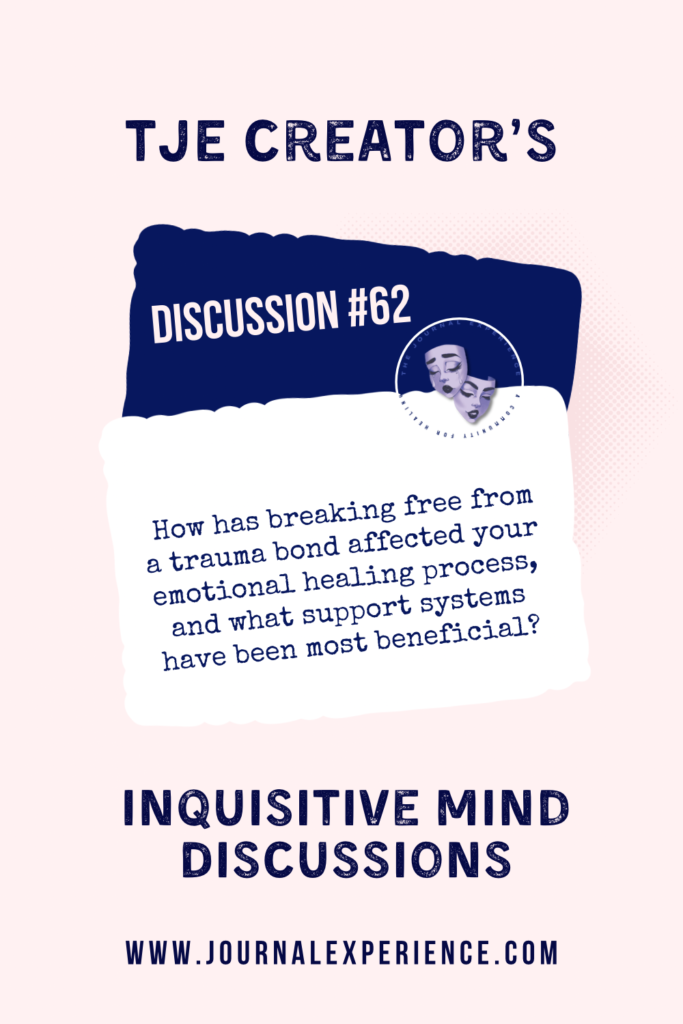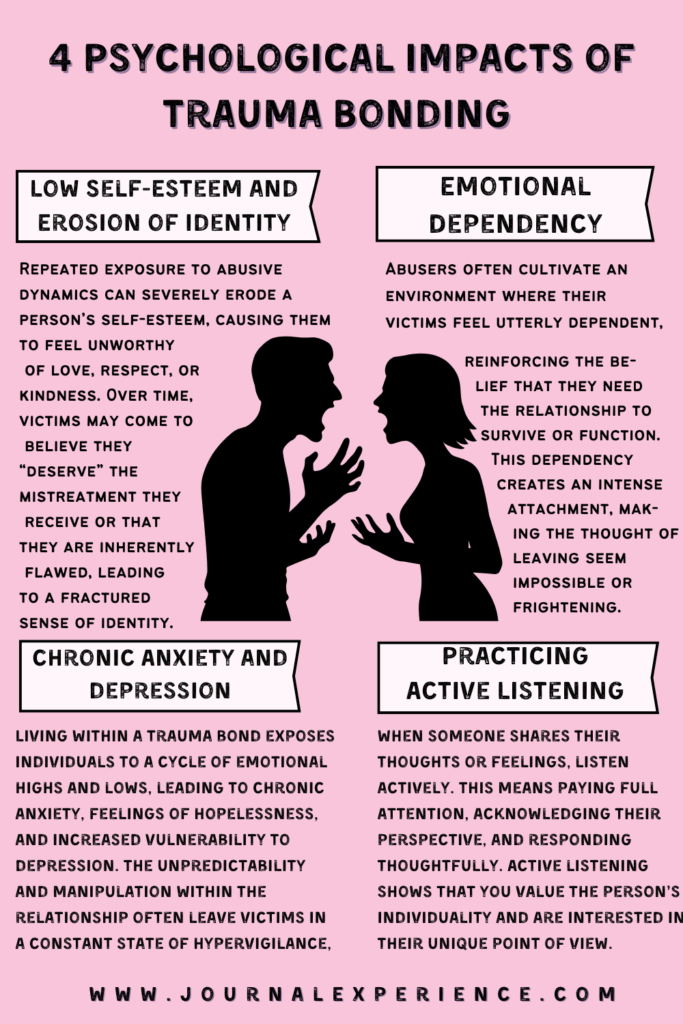Trauma bonding is a complex and intense connection that often forms in abusive relationships. This attachment becomes a cycle of dependency and emotional entanglement, where individuals feel trapped and find it difficult to break free.

Through greater awareness and informed steps, you can move toward healthier connections and reclaim your emotional freedom.
This blog post delves deeply into the nature of trauma bonding to help readers understand the signs, recognize the damaging effects, and take actionable steps toward healing and preventing it in future relationships.
Signs Trauma Bonding
Trauma bonding is a psychological response to abuse, where someone develops a deep attachment to their abuser. This attachment is driven by a cycle of positive and negative reinforcement, leaving the individual feeling confined in a relationship that is, paradoxically, both comforting and harmful. Let’s explore the factors that contribute to trauma bonding and why it exerts such a powerful hold over individuals:
- Cycle of Abuse and Affection: Trauma bonds grow stronger through a repeated pattern of mistreatment followed by moments of kindness or affection. This push-and-pull dynamic instills a sense of hope that things will improve, fostering a cycle of dependency on the abuser.
- Hormonal Influence: The body’s natural response to both positive and stressful moments—through hormones like oxytocin and dopamine—strengthens attachment. In contrast, stress hormones such as cortisol are elevated during negative experiences, reinforcing survival instincts that make it harder to break free.
- Emotional Confusion and Cognitive Dissonance: Those caught in trauma bonds often feel torn between feelings of love and the painful awareness of mistreatment. This cognitive dissonance creates confusion and guilt, trapping them in an emotional loop that’s hard to escape.
- Examples of Trauma Bonding Situations:
- Remaining in a relationship despite enduring persistent emotional abuse in the hope of change.
- Interpreting abusive behavior as a sign of “deep connection” or intense love.
Recognizing the Signs of Trauma Bonding
Identifying the signs of trauma bonding is essential for anyone seeking freedom from a harmful relationship. Trauma bonds often masquerade as love or loyalty, making it difficult to recognize unhealthy dynamics. However, there are specific markers to look for:
- Justifying or Rationalizing Abusive Behavior: People who experience trauma bonds may downplay or rationalize the severity of the abuse, convincing themselves that the abuser “didn’t mean it” or that “it wasn’t that bad.”
Example: Justifying a partner’s anger or violent behavior as due to external stress rather than recognizing a pattern of abuse.
- Feeling Trapped or Powerless: Even when they desire to leave, individuals may feel incapable of doing so due to fear, financial dependency, or emotional vulnerability.
Example: Staying with an abusive partner due to fear of loneliness or concern about the abuser’s reaction to a breakup.
- Extreme Loyalty to the Abuser: Trauma bonds often foster intense loyalty, even in damaging situations, leading individuals to defend the abuser’s actions despite the harm they endure.
- Distorted Self-Worth: Over time, repeated abuse erodes self-esteem, causing individuals to feel undeserving of respect or better treatment.
- Obsessive Thoughts and Preoccupations: Individuals caught in trauma bonds may find themselves constantly replaying the highs and lows of the relationship or fantasizing about a future that justifies staying.

The Psychological Impact of Trauma Bonding
The emotional and mental toll of trauma bonding is profound and long-lasting, reshaping a person’s self-image and deeply affecting their ability to engage in healthy relationships. Trauma bonding often creates a distorted view of oneself, leading individuals to believe they are somehow responsible for the abuse they endure, further entrenching feelings of powerlessness. This powerful psychological impact manifests in several ways, each contributing to a cycle of dependency and emotional pain.
- Low Self-Esteem and Erosion of Identity: Repeated exposure to abusive dynamics can severely erode a person’s self-esteem, causing them to feel unworthy of love, respect, or kindness. Over time, victims may come to believe they “deserve” the mistreatment they receive or that they are inherently flawed, leading to a fractured sense of identity.
Signs: Persistent feelings of inadequacy, shame, or believing they are “lucky” that the abuser stays with them can become deeply ingrained, making self-compassion difficult.
- Emotional Dependency: Abusers often cultivate an environment where their victims feel utterly dependent, reinforcing the belief that they need the relationship to survive or function. This dependency creates an intense attachment, making the thought of leaving seem impossible or frightening.
Example: In the abuser’s absence, individuals may experience overwhelming anxiety or find it challenging to perform day-to-day tasks, as they have come to rely on the abuser’s presence—even if harmful—as a source of stability.
- Chronic Anxiety and Depression: Living within a trauma bond exposes individuals to a cycle of emotional highs and lows, leading to chronic anxiety, feelings of hopelessness, and increased vulnerability to depression. The unpredictability and manipulation within the relationship often leave victims in a constant state of hypervigilance, where they feel perpetually on edge and struggle to find peace.
Effects: This emotional turmoil can manifest as a pervasive sense of sadness, difficulty finding joy, or a paralyzing fear of the future, contributing to a deep-seated feeling of despair that makes recovery seem distant.
- Difficulty Trusting Others: Trauma bonding damages not only the victim’s self-image but also their ability to trust others, which can make future relationships difficult to navigate. Having been repeatedly hurt by someone they once trusted deeply, individuals often develop a pervasive mistrust that extends to others, complicating their ability to form healthy and supportive connections.
Impact on Relationships: This mistrust may cause them to question the intentions of genuinely supportive people, making it hard to open up and feel safe, which can lead to isolation and loneliness.
The psychological impact of trauma bonding is a deeply rooted and challenging obstacle to overcome, affecting multiple aspects of an individual’s mental and emotional well-being. However, recognizing these impacts is a crucial step toward healing, as it allows individuals to understand the depths of their experiences and begin to rebuild their self-worth, independence, and trust.
If trauma bonding has left you emotionally depleted, disconnected from yourself, or stuck in unhealthy patterns, the Healing The Inner Trauma Child (HITCH) Method offers a guided path to rebuild emotional resilience, reconnect with your identity, and heal at the root level.
Steps to Heal from Trauma Bonding
Recovery from trauma bonding requires a multi-faceted approach that focuses on rebuilding self-worth, setting boundaries, and learning to navigate life independently. Here’s a step-by-step path toward healing:
- Acknowledgment and Self-Awareness: Recognizing a trauma bond as unhealthy is the first essential step. Understand that these attachments are not normal, and it’s valid to want to leave.
- Building a Support System: Leaning on friends, family, or support groups provides emotional reinforcement and valuable perspective.
Suggestion: Explore supportive communities like The Journal Experience, where members share similar experiences and provide encouragement.
- Establishing Boundaries: Setting physical and emotional boundaries is crucial to severing dependency.
Tip: Gradually create distance by limiting contact with the abuser, allowing space to regain independence.
- Seeking Therapeutic Support: Therapy offers a safe environment to explore and address the emotional wounds left by trauma bonding.
- Cognitive Behavioral Therapy (CBT): This approach helps individuals reframe negative thoughts and develop healthier coping strategies.
- Engaging in Self-Care: Self-care practices that support emotional, mental, and physical well-being play a vital role in recovery.
Suggestions: Adopt self-affirming routines, such as journaling, meditation, or engaging in physical activities that reinforce self-worth.
If you’re struggling to detach or reclaim your emotional independence, the Codependency Therapy | Self Love Recovery Treatment Program offers structured guidance to break free from trauma-bonded relationships and begin rebuilding a life grounded in self-respect and emotional safety.

Preventing Trauma Bonding in Future Relationships
To avoid trauma bonds in future relationships, it’s essential to recognize healthy dynamics and set firm boundaries. These preventive steps can pave the way for relationships that are safe, supportive, and mutually respectful:
- Recognizing Early Red Flags: Learn to identify behaviors that indicate control, manipulation, or disregard for boundaries to avoid potential trauma bonds.
- Example: A partner who frequently oversteps boundaries or emotionally withdraws to punish may signal an unhealthy pattern.
- Setting and Maintaining Boundaries: Boundaries safeguard your individuality and ensure your needs are respected in a relationship.
- Tips for Boundary Setting: Communicate personal limits confidently and assertively without fear of rejection.
- Prioritizing Self-Worth: Remember that a healthy relationship should uplift, not undermine, your well-being. Confidence and self-respect are key to avoiding dependency.
- Building a Healthy Support System: Friends, family, and communities that value your growth serve as buffers against harmful relationships.
- Suggestion: Join support groups like The Journal Experience to reinforce positive relational patterns.
Understanding the psychological roots of trauma bonding is essential to long-term recovery. The Webinar: Origins of Codependency and Pathological Narcissism offers deep insight into how these bonds are formed and how to prevent repeating toxic patterns in future relationships.
Overview
Breaking free from trauma bonding is more than just leaving an unhealthy relationship; it’s a deep, transformative journey of self-discovery, resilience, and empowerment. Trauma bonding often leaves individuals feeling stripped of their sense of self, caught between dependency and an overwhelming desire to heal.
This process of breaking free isn’t merely about physical distance but involves untangling layers of emotional attachment, understanding complex feelings, and gradually rebuilding one’s self-worth.
It is a path filled with challenges, but it is also one that promises growth, freedom, and the rediscovery of one’s intrinsic value and autonomy.
Healing from trauma bonds requires not only understanding and compassion but also a powerful commitment to recovery.
Recognizing that it’s okay to seek help and that healing doesn’t happen in isolation is a crucial step forward. A strong support network, such as family, friends, or dedicated support communities, can provide encouragement, understanding, and the strength to move forward when the journey feels daunting.

For those seeking to connect with others who understand and support their healing journey, consider joining The Journal Experience. Becoming a member or subscribing to the TJE Newsletter offers access to a supportive community and resources for recovery. Together, we can build healthier, more fulfilling relationships. Join us today and take a step toward reclaiming your life.